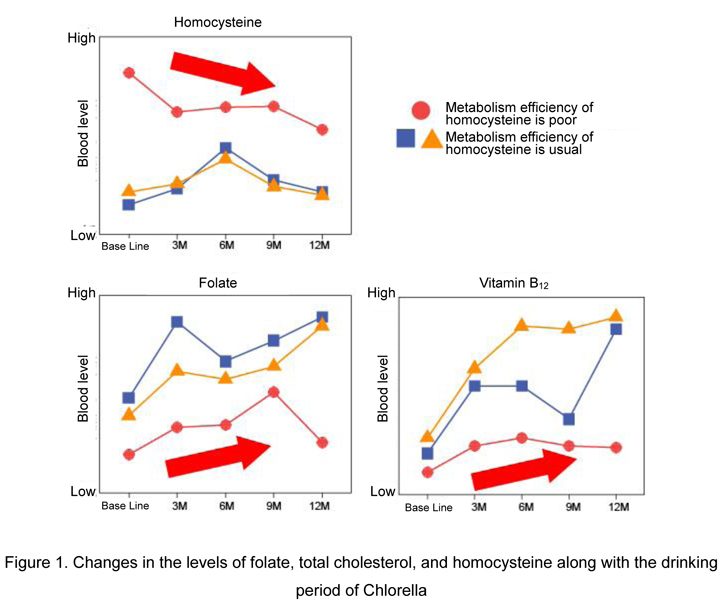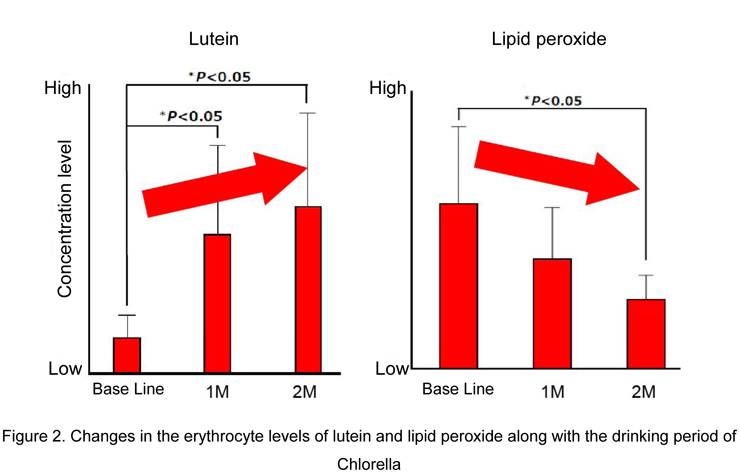- TOP
- List of reports
- A relationship between Chlorella and risk factors of vascular dementia
A relationship between Chlorella and risk factors of vascular dementia
【Scientific information】
Research and Development Department, Sun Chlorella Corporation
A relationship between Chlorella and risk factors of vascular dementia
Presented at the 17th Annual Meeting of Japan Society for Early of Dementia
- Objectives
- Risk factors of vascular dementia include diabetes, dyslipidemia, and hyperhomocysteinemia. It has been also reported that blood of patients with dementia contains abundant senescent erythrocytes, of which concentration of lipid peroxide is high. Folate and vitamin B12 are involved with metabolism of homocysteine, while lutein is involved with inhibition of lipid peroxide production. We have evaluated the effect of drinking Chlorella, which contains these nutrients, on blood homocysteine and lipid peroxide by conducting tests in (1) healthy adult men as well as in (2) healthy middle- and old-age men and women.
- Methods
- 1. Three healthy adult men were determined as subjects. Four grams of Chlorella was drunk twice a
day in the every morning and evening for 1 year. A test of MTHFR genotype*, which is involved
with metabolism efficiency of homocysteine, as well as blood levels and changes in gene expression
of folate, vitamin B12, and homocysteine were examined every 3 months. It has been reported that
blood levels of folate and vitamin B12 are low, while that of homocysteine is high in subjects with a
genotype of MTHFR, of which metabolism efficiency of homocysteine is poor.
2. Twelve healthy middle- and old-age men and women were determined as subjects. Four grams of Chlorella was drunk twice a day in the every morning and evening for 2 months. Erythrocyte levels of lipid peroxide and lutein were evaluated every 1 month. Lutein is a major antioxidant ingredient in erythrocytes.
- Results
- 1. Homocysteine level,a risk factor of dementia was confirmed to be greatly reduced in subjects with a
genotype of MTHFR, of which metabolism efficiency of homocysteine is poor. Also, blood levels of
folate and vitamin B12 has increased as well as expression level of the gene, which is related to the
usage efficacy of folate and vitamin B12 has also increased in all subjects. (Figure 1)
2. The erythrocyte level of lutein has increased at 1 month after starting intake of Chlorella (P < 0.05). The erythrocyte level of lipid peroxide has decreased since 1 month after starting intake of Chlorella and has significantly decreased at 2 months (P < 0.05). (Figure 2)
Based on the above results, long-term ingestion of Chlorella was suggested to lead to prevention of vascular dementia.


Terminology
- * A test of MTHFR gene that is involved with metabolism efficiency of homocysteine
- It was a gene called MTHFR and about 16.7% of Japanese was reported to have a type of the gene, of which usage efficacy of folate that is involved with metabolism efficiency of homocysteine was low.
Details
- meeting:
- The 17th Annual Meeting of Japan Society for Early of Dementia
- Title:
- Is Chlorella food involved with risk factors of vascular dementia?
- Effect on the plasma homocysteine level and the blood lutein level - - Authors:
- Masaki Fujishima1), Masato Ohnishi1), Yukari Arakawa1), Hideo Takekoshi1),
Teruo Miyazawa2) - Affiliation:
- 1) Sun Chlorella Corporation, 2) New Industry Creation Hatchery Center, Tohoku University (NICHe)





